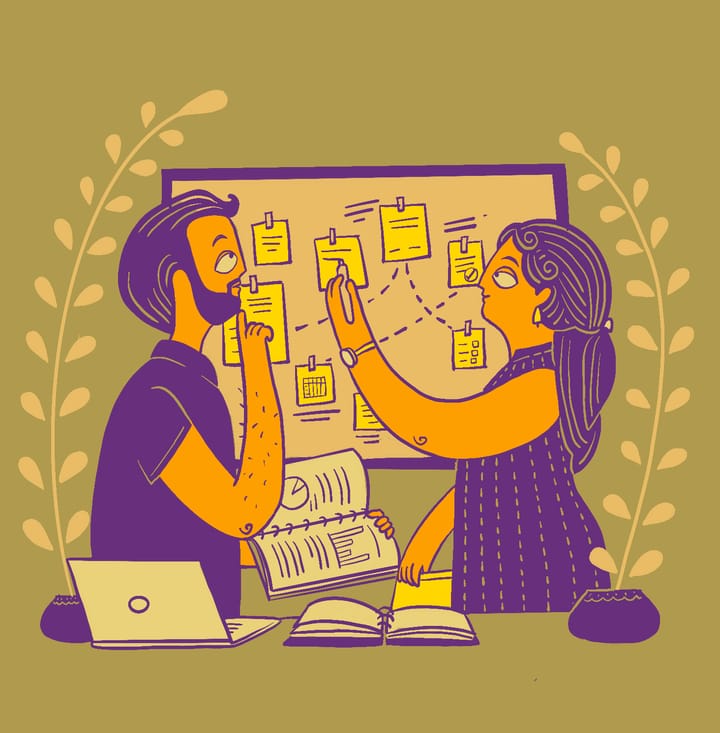Depression and Anxiety in Children and Adolescents
Anxiety and depression are common mental health problems among children too

By Santanu
Note from editor: In today’s competitive world, children are under tremendous pressure to excel in both academic and extra-curricular activities. Children are also forced to follow rigid schedules and conform to the expectations of their parents and teachers, which further affects their mental health.
The article below will help you identify the signs of depression or anxiety in your child and walk you through some steps to care for them. And if you would like to speak to a parenting expert now, please click here. Enjoy the article!
***
As a high achiever in school, Arshiya put pressure on herself to be the topper in her class. In her final year, she began getting anxious: Would she do well in the board exams? Would she get into a college of her choice? What if she did badly in the examinations? She was constantly feeling low, and had occasional thoughts of suicide. She was unable to focus on her studies, was constantly feeling tired and would complain of headaches.
When Arshiya’s parents sought help for her, the counselor helped them understand that Arshiya had built her entire sense of self on being academically excellent. With the stress of her board exams, she thought her position as an achiever was being challenged, and was unable to see a reality in which she didn’t do well academically. These ideas were causing her anxiety and depression for a few months.
It’s a common misconception that young children and adolescents have no expression of intense emotion, and therefore are unlikely to experience common mental health issues such as depression or anxiety.
The facts
At least four per cent of children under the age of seven years will experience depression and/or anxiety disorders during their childhood.
In children aged eight and above, up till adolescence, the prevalence of depression goes up to nearly nine per cent. This is roughly the same prevalence of these disorders in adults.
If not treated, these conditions have a possibility of becoming chronic. They could continue into adolescence and adulthood. Early detection and treatment can help the child cope with their issues and get better.
Children feel sad, upset and go through a range of emotions through their growing years. For some children, these feelings may persist for a longer duration, and have an effect on their emotional and mental health.
Depression and anxiety can be very real concerns among children and adolescents, and they very often coexist. It can affect how the child thinks, feels and behaves, and affect the quality of their life.
Identifying depression and anxiety in children and adolescents
Unlike Attention Deficit Hyperactivity Disorder (ADHD), depression and anxiety are childhood mental disorders in which the symptoms are not always outwardly visible or noticeable. These disorders cause only a subtle change in the child’s behavior and functioning. Parents may fail to notice the existence of these disorders.
Young children experiencing depression, anxiety or phobic anxiety may not be able to articulate their feelings and their emotional challenges.
In adolescents who develop depression, the symptoms are noticeable by the age of 11 or 12. This is a period of transition, when the child’s body is going through physical, emotional and hormonal changes. Parents and teachers who notice symptoms may attribute the changes in behavior to a passing phase, and assume that the child will get back to normal in a few weeks or months. While many children do go through behavioral changes as they grow up, others may have a mental health issue that needs to be addressed. It’s crucial for parents to observe any behavior that is out of the ordinary, and which persists beyond 2-3 weeks, and seek help for it.
Anxiety disorders in children and adolescents
Children may be vulnerable to different kinds of anxiety disorders. These anxieties may be common among toddlers and younger children. However, if these anxieties persist even after the child is aged five, and affect the child’s daily functioning, you may need to seek help.
Social anxiety disorders: The child feels anxious about interacting with other people.
Phobic anxiety: This refers to specific fears. Some common fears among children are fear of spaces, heights, animals and darkness.
Separation anxiety: Where the child fears that they will be separated from their caregiver. This is mostly seen in children aged between two and three years old.
Older children and adolescents may have performance anxiety linked to their academic success or failure.
Performance anxiety: This anxiety is caused by the idea that self-worth and success are to be measured by academic performance. This anxiety is seen among adolescents who do well in academics (because they fear slipping up and losing their identity as good performers) as well as students who are not doing well in academics (who think they are inferior, or failures). Adolescents may also have a high level of anxiety about their future; they may have recurring thoughts along these themes: What if I fail? What if I can’t make it in life? What if I’m not good enough? Will I be successful?
Depression in children and adolescents
In today’s competitive world, children have unnecessary pressure to excel in academics and extra-curricular activities. The child may be forced to follow a rigid schedule and conform to certain rules. This can be one of the major causes of depression in children, as they spend a lot of their time learning, whether at home or in school. At the same time, there are other psychosocial factors that may also affect the child’s mental health. Children who cannot handle emotional and mental upheavals may be susceptible to depression.
Depression in children and teens may be due to:
- Prolonged mental stress arising out of conflicts at home, for example, dealing with an alcoholic parent or due to parents’ conflicts
- Traumatic events such as violence, physical or mental abuse, or neglect
- Learning problems that affect the child's self-confidence and ability
- Other untreated psychiatric disorders such as anxiety disorders
Depression among children can vary from being mild to moderate or severe.
Mild depression can cause a child to feel unhappy, but the child will be able to lead a normal life. The child may not show much interest in doing daily tasks or school work, but with the parents' support and with simple lifestyle changes, the child can recover from mild depression.
Moderate depression can significantly affect the child's life. The child may constantly feel miserable and low. If you think that your child shows these signs of depression, contact your family doctor and seek the help of a mental health expert.
Severe depression can cause the child to feel worthless. The child may also have constant negative thoughts and feelings of sadness that he or she is unable to cope with. If your child shows signs of being severely depressed, it is advisable to take your child to the doctor and begin treatment at the earliest.
Identifying depression in children
Children who are less than eight years old and who experience depression may display the following behaviors:
- Irritability
- Clinging to parents or caregivers
- Frequent tantrums and/or crying spells
- Drastic changes in sleeping and eating habits
- Refusal to go to school; losing interest in studies
- Refusal to play with friends
- Frequently complaining about headaches or stomachaches that don’t respond to treatment
It’s important to remember that sometimes, these behaviors may be present for a few hours or days. However, if you observe your child consistently displaying these behaviors for two or three weeks at a stretch, there is a possibility that the child may have depression. It is best to seek help to understand what the problem is.
Identifying depression in adolescents
Children over the age of eight years, and adolescents, show symptoms of depression similar to that seen in adults. These may include:
- Changes in sleep and appetite
- Sadness of mood (prolonged spells)
- Frequent mood swings
- Lack of interest in pleasurable activities
- Getting tired easily, or feeling lethargic most of the time
- Aggressive behavior
- Articulation of death wishes (I wish I was dead, life is just not worth living)
- Talking about suicide, or actually attempting suicide
A child who has anxiety or depression may refuse to go to school; they may stay at home all day even when they are not ill, and indulge in passive activities such as watching TV or listening to music. Their schedule becomes irregular, and they avoid studying or doing homework even when at home. This may impact their grades, causing them greater anxiety. The child may then feel they are caught in a vicious circle.
During adolescence, these behaviors may be present for a few hours or days. However, if you observe your child consistently displaying these behaviors for two or three weeks at a stretch, you will need to seek help.
Children and adolescents who have developmental conditions or disorders in early childhood, and particularly those who have specific developmental speech delays, language challenges, intellectual disability or autism, may not display the same symptoms of depression and anxiety as others. This often poses challenges in identification and diagnosis. If your child has any of these challenges, make sure that you discuss any concerns or behavioral changes with your mental health professional.
It’s important to keep the developmental perspective in mind if you suspect that your child has depression or an anxiety disorder.
Behaviors that are developmentally appropriate:
A two-year-old throwing a tantrum
Behavioral irregularities existing for a few hours or days
Child has happy and sad moods; or have certain fears, but these do not impair their functioning
You may need to seek help if:
An eight-year-old is frequently throwing tantrums (developmentally inappropriate)
Behavioral irregularities are shown over 2-3 weeks.
Moods, symptoms or fears affect:
- The child’s functioning or self-care. The child does not eat, sleep or groom themselves regularly.
- The child’s social interaction: They refuse to go out to play with friends, or to spend time with family. They withdraw into their own world
Treatment for anxiety and depression
Depression affects the child’s physical and mental health, academic performance and their daily activities. If you notice your child displaying the symptoms listed above, consult a pediatrician or a mental care expert. Young children with mild to moderate anxiety and depression can get better with therapy and other forms of treatment. Techniques such as art and play therapy can be very useful in helping them cope. Older children and adults may benefit from Cognitive Behavior Therapy (CBT) and similar therapies.
Children and adolescents with mild depression or anxiety primarily require therapy to cope.
Children with severe depression or anxiety may require medication in addition to therapy. The dosage for children and teenagers is usually lower than the normally recommended dosage for adults. If your child is being prescribed medication, the psychiatrist will ask you to go in for frequent follow-ups to monitor your child for any side effects.
If you have any concerns about psychiatric medication for your child, do check with your psychiatrist, and explore what your other options may be.
For parents: Caring for a child with anxiety or depression
As a parent, you may find it hard to understand your child’s experience of depression or anxiety. You may also be going through your own worries and guilt about your child’s illness. As a caregiver, you can care better for your child if you understand the illness. Speak to your psychiatrist or counselor to clarify all your doubts.
Make sure your child gets professional support as soon as possible.
Provide adequate support within the family by spending quality time with your child. Don’t trivialize the child’s symptoms, criticize their behavior or compare them with others. Speak to them about their experiences and give them a patient ear.
Children with acute anxiety or depression may have suicidal thoughts. Speak to your mental health professional about how you can handle this, and ensure the safety of your child accordingly.
If you feel overwhelmed, reach out to a counselor for support.
For adolescents: Coping with depression or anxiety
If you think you may have anxiety or depression, you may be feeling exhausted or overwhelmed. You may have some distressing thoughts that make you feel low or nervous.
If you think you have been experiencing any of the symptoms listed above, please seek help immediately. You could speak to a trusted adult and ask for support. Once you meet with a mental health professional, ensure that you follow the prescribed treatment plan.
If you are troubled by distressing thoughts, try keeping yourself engaged with activities that will distract you from them: art, sport, music, reading, meditation and yoga have been known to help. You could also speak to your counselor to understand what coping strategies may be most helpful for you.
Peer support helps. If you have a trusted friend, speak to them about your feelings, and ask for their support, particularly if you need them to do something specific.
This article has been republished with permission from the Mental Illness Section of the White Swan Foundation's website.
If you liked this article, you might be interested in joining our parenting community. Click here to visit the community page.
Related articles:
Tips to Manage Your Mental Health as a Single, Working Parent
Parents and Teachers Should Collaborate to Help a Child with a Learning Difficulty



